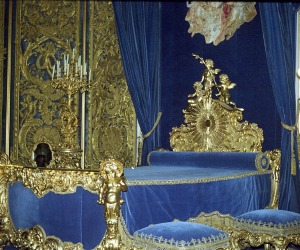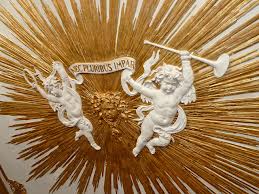“Mad” King Ludwig II of Bavaria was found dead in Lake Starnberg on June 13, 1886. He was 40 years old. The cause of death is still mysterious, but his death was convenient for a lot of people in Bavaria, where he had pretty much given up on the day-to-day business of governing. Government of Bavaria ground to a halt while Ludwig spent all his money (mostly his own personal fortune) on increasingly theatrical castles and palaces. He had been declared insane the previous day and was in some kind of royal “protective” custody.
After a couple of misses, I was finally able to visit Linderhof Palace, King Ludwig II’s favorite home, at a time when the grotto was open. I was anxious to see it, especially after watching Luchino Visconti’s very fine film Ludwig, about the life and mysterious death of the notorious Bavarian king.
Ludwig built Linderhof as his own personal getaway. In fact, it was the ultimate bachelor pad. But he enjoyed the place in solitary splendor; he rarely if ever had visitors. He built a special music room for his favorite composer, Richard Wagner, but Wagner never saw it. The grounds are breathtaking, and because the palace is quite small, each room looks out onto a beautiful manicured view with pristine mountains in the background.
In Visconti’s 1972 film Ludwig, the king is played by Visconti’s real-life romantic partner and muse, Helmut Berger.
The film shows Ludwig lounging around in his grand surroundings with hand-picked servants and a handsome young actor. Filming took place in the palace, so watching it is like having a tour personally conducted by the very strange and romantic Ludwig himself. His bedroom (intentionally) recalls the bedroom of King Louis XIV of France. This is a one-man palace; there are no guest rooms. The help stayed in outbuildings, invisible to the king until they were needed.
It is hard to say how accurate the life story is. But it is certain that Ludwig was an eccentric and dreamy romantic. His people loved him, but he was not much of a king when it was time to hang the ermine in the closet and get some work done.
One of Ludwig’s very few friends was his cousin, the Austrian Empress Elisabeth, nicknamed Sisi. She was famously married to the Emperor when she was only 15, and spent the rest of her life wanting out. She is played by Romy Schneider (who also played Sisi in the very silly but entertaining semi-fictional series of Sissi movies).
The grotto was built up the hill behind the castle. The entrance looks like a fort a very ambitious child might build.
But the grotto itself is as jaw-droppingly weird and beautiful as it was in Ludwig’s day. He had Wagner’s operas performed inside for his own personal pleasure. The water was heated, so that he could swim in it if he tired of being rowed around in his gilded shell boat. And the lighting could change colors depending on his mood, or the mood of the opera scene.
The grotto is still festooned with the floral swags that Visconti’s movie crew put up. The film has a fantastic scene where an Austrian actor is taken into the grotto to meet Ludwig, who wants him to recite dramatic speeches 24/7. Helmut Berger, as Ludwig, floats out of the gloom in his shell boat, wearing a dark overcoat and a black Homburg–with an enormous diamond brooch pinned to the side. He fixes the actor with an imperious, piercing stare. The actor tries hard to be Ludwig’s New Best Friend, but the friendship ends badly and Ludwig is alone again.
Nearby Neuschwanstein and Hohenschwangau Castles are justly famous, but they are overrun with tourists. Armed with a Bavarian Castles Pass, I actually went to Linderhof twice during my last trip. One day it was rainy, the next it was sunny. I can’t say I had the place to myself, but there was time and space enough to ponder the mysterious life of Ludwig.
Join me next time for more explorations in the art and history of Europe!


















